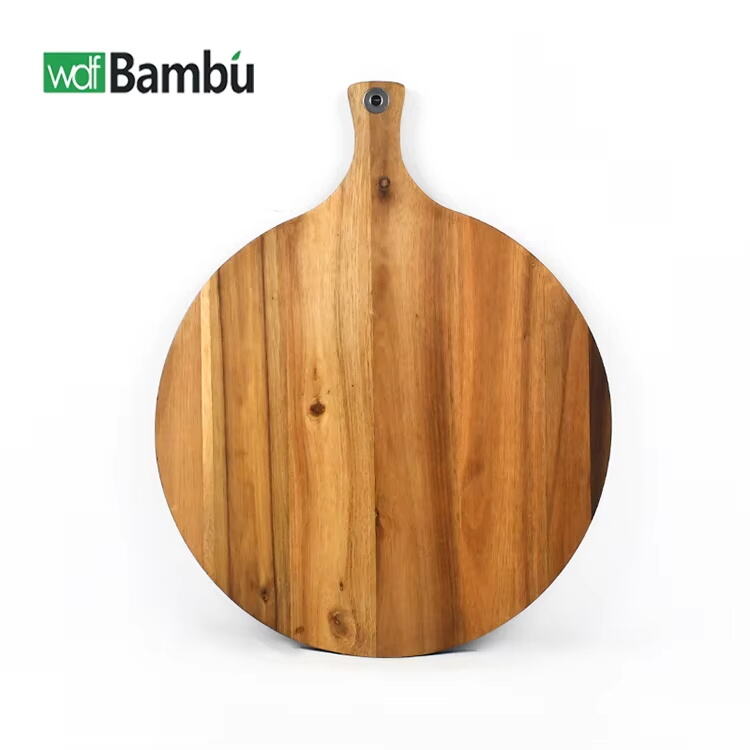Introduction
Brief Overview of the Popularity of Bamboo Chopping Boards
People love bamboo chopping boards these days because they're good for the planet and look really nice too. A recent poll from 2022 showed about half the people asked preferred bamboo when compared to other options, mostly because it comes from renewable sources and just looks better on the counter. Home cooks find them tough enough to handle regular cutting without getting damaged, plus there's something about those natural bacteria fighting qualities that makes sense for food prep areas. Professional kitchens stock up on them too. The fact that bamboo isn't heavy means moving it around isn't a hassle during meal prep time. And let's face it, nobody can deny how cool those wood grain patterns look sitting next to stainless steel appliances in modern kitchens.
Introduction to How the Manufacturing Process Can Influence the Final Product Quality
How bamboo chopping boards are made really affects how strong, long lasting, and good quality they actually turn out to be. When makers pick the right kind of bamboo and then apply careful processing methods along with proper finishing work, that makes all the difference in how well these cutting surfaces hold up during daily kitchen use. Home cooks who take time to learn about what goes into making these boards will find themselves better equipped to shop smart for their culinary needs. Looking at the connection between factory practices and final product quality helps explain why some brands just perform better than others over time. For anyone serious about cooking at home, supporting companies that stick to solid production standards isn't just about getting something that lasts longer it also means fewer replacements down the road.
Sourcing Bamboo
Importance of Selecting High-Quality Bamboo
The type of bamboo matters a lot when making chopping boards that last and work well in the kitchen. Most people go for Moso bamboo because it's really tight and compact. The density makes a big difference both when cutting food and how long the board stays useful before needing replacement. Some tests done at a bamboo research center showed that better quality bamboo actually lasts about 30% longer than cheaper options. That's pretty impressive considering how much wear and tear these boards get daily. Plus, this dense material works great in home kitchens while being kinder to the environment compared to other materials that take more resources to produce.
Impact of Sustainable Harvesting on Board Quality
The way we harvest bamboo makes all the difference when it comes to keeping our cutting boards top quality and lasting longer than usual. When growers pick only certain parts of the bamboo grove instead of clear cutting everything at once, the plants actually grow back faster. This means there's always enough good quality bamboo available for making kitchenware. Plus, this approach keeps the bamboo strong so cutting boards don't warp or crack as easily over time. Many shoppers now look for labels showing the bamboo was harvested sustainably. These certifications help people know they're getting something that's both environmentally friendly and built to last. For anyone who spends money on kitchen tools, knowing their bamboo cutting board won't fall apart after a few months is worth every penny spent on proper sourcing practices.
Processing the Bamboo
Methods of cutting, drying, and preparing bamboo.
Making bamboo chopping boards starts with careful cutting, proper drying, and some pretty specific prep work to get good results. Getting the right moisture level matters a lot, so folks who make these boards know they need to cut the bamboo just right and let it dry for exactly the right amount of time. If the cuts aren't timed properly or if the drying isn't controlled, the bamboo tends to bend or crack, ruining what could have been a great cutting surface. Most artisans use either air drying or kiln drying techniques depending on their setup and needs. The choice between these methods really affects how tough the finished board will be and how well it holds up during regular kitchen use. Some makers swear by certain drying approaches because they've seen better results over years of trial and error when crafting durable bamboo cutting boards that last through countless meals.
How improper processing can lead to weak or warped boards.
When bamboo cutting boards aren't processed correctly, their structure just isn't as strong anymore, and this often leads to issues such as warping or splitting over time. Research indicates that badly made boards might actually lose around 25 percent of what makes them sturdy when compared to properly manufactured ones. Look closely at the surface quality too - if there are bumps, dips or uneven thickness throughout the board, that's usually a sign something went wrong during production. Smart shoppers keep an eye out for these flaws because nobody wants a cutting board that breaks down after only a few months of regular kitchen use. Spotting these problems early means getting better value from our purchases in the long run.
Assembly and Gluing
The Role of Adhesives and Their Impact on Durability
Glue matters a lot when putting together bamboo chopping boards since it affects how long they last. When makers choose good quality, safe for food glues, the boards stand up better to daily kitchen work without breaking apart or getting those annoying cracks. Moisture resistant adhesives are particularly important for bamboo boards. These special glues help them last longer because they stop the wood from rotting when someone washes the board after cutting vegetables or meat. Quality really counts here. A bad job with the glue means the board won't last very long at all, which defeats the whole point of using bamboo in the first place since it's supposed to be eco friendly and sustainable.
How Proper Gluing Techniques Prevent Board Separation or Cracking
Getting the glue right is really important when making bamboo chopping boards that hold together well over time. The process starts by spreading glue evenly across all surfaces and then applying enough pressure while putting everything together so pieces don't come apart later. Many experienced makers prefer cold pressing techniques because they strengthen how the bamboo strips stick together, which means fewer cracks down the road. When good quality bamboo meets proper gluing skills along with decent adhesive products, what comes out is something durable enough to last through years of kitchen use without falling apart. Paying attention to these details prevents problems like wobbly edges or warped boards, giving home cooks something reliable to chop on day after day.
Finishing and Sealing
Importance of Finishing Processes (Sanding, Oiling) for Smoothness and Hygiene
Finishing steps like sanding and oiling really make all the difference when it comes to getting smooth bamboo chopping boards that feel great in hand during cooking prep. When properly sanded down, these boards end up without splinters and look much nicer too while creating a cleaner space for cutting vegetables and meats. The smoother surface just doesn't catch onto bacteria as easily, something every home cook knows matters after slicing raw chicken on their counter. Mineral oil works wonders once applied since it soaks into the bamboo grain itself, protecting against water damage and stubborn food marks over time. Regular oiling builds up this protective layer naturally, keeping the board looking fresh longer even after years of daily kitchen duty.
The Effect of Sealing on Moisture Resistance and Longevity
When we talk about bamboo chopping boards, sealing them really makes a difference in how long they last. Good quality sealants stop water from getting into those tiny bamboo fibers, which means less chance of the board bending out of shape or swelling up after cutting veggies. Most people find that applying fresh sealant roughly every three to four months keeps things working smoothly. The key thing is making sure that protective layer stays strong so the board doesn't get damaged when exposed to moisture over time. Boards that stay properly sealed tend to hold up much better against daily wear and tear, staying usable and looking good on the kitchen counter for several years at least. While some might see this as extra work, most users agree it's worth the effort compared to dealing with warped boards that need replacing sooner than expected.
Conclusion
What makes a good bamboo chopping board depends heavily on how it gets made, right from where they source the bamboo all the way through to final touches. Picking top grade bamboo matters most because this sets the whole tone for how solid and reliable the board will be. During processing, things like proper kiln drying of those bamboo strips and using strong glues really count when trying to keep the board stable and stop it from warping over time. How they put everything together matters too, since poor assembly leads to weak spots that break down faster than expected. When folks understand what goes into making these boards, they're better equipped to pick something that actually lasts and performs well during regular kitchen use instead of ending up with another cheap cutting board that needs replacing every few months.
If someone wants good bamboo chopping boards, checking for proper certifications is pretty important since they show the company actually uses decent materials and follows eco-friendly practices. These certifications basically tell us if we're getting something worth our money. Next step? Take a close look at the board itself. Are there any gaps between the pieces? Does it feel rough in spots? Those kinds of flaws usually mean poor workmanship during production. We should go for boards that openly talk about how they make them and what glues they use too. Companies willing to share that info tend to care more about making quality products. Following these simple guidelines helps people pick out chopping boards that last longer while supporting environmentally responsible manufacturing.
FAQ Section
What makes bamboo chopping boards eco-friendly?
Bamboo chopping boards are considered eco-friendly because bamboo is a renewable resource. It grows quickly and can be harvested without causing deforestation. Additionally, sustainable harvesting practices ensure the long-term availability of high-quality bamboo.
How should I maintain my bamboo chopping board to ensure longevity?
To maintain your bamboo chopping board, apply mineral oil regularly to keep it moisturized and flexible. Avoid soaking it in water, and instead, clean it with a damp cloth and mild soap. Make sure it's dry before storing to prevent moisture damage.
Are bamboo chopping boards safe for food preparation?
Yes, bamboo chopping boards are safe for food preparation. They naturally resist bacteria and are less likely to retain odors compared to plastic boards. However, regular cleaning and oiling are recommended to maintain their hygienic qualities.



 Home
Home